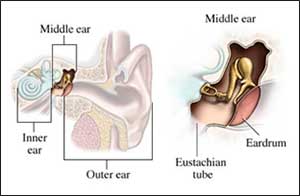
The middle ear is located behind the eardrum and can become infected and inflamed. When this happens, it is usually the result of a virus or sometimes exposure to specific bacteria. According to the American Academy of Otolaryngology (AAO), “fluid can remain in the ear for weeks to many months. When a discharge from the ear persists or repeatedly returns, this is sometimes called chronic middle ear infection. Fluid can remain in the ear up to three weeks following the infection. If not treated, chronic ear infections have potentially serious consequences such as temporary or permanent hearing loss.”
The Middle Ear

Copyright© Nucleus Medical Media, Inc.
Causes
Most middle ear infections occur following “a cold, allergy, or upper respiratory infection, when bacteria or viruses cause the accumulation of pus and mucus behind the eardrum. This results in the eustachian tube being blocked, which, in turn, causes earaches and swelling.
Risk Factors
Middle ear infections, also called acute otitis media, are most common in infants and toddlers, and they occur more often during the winter months. Other factors that may increase the likelihood of a middle ear infection include:
- Recent viral infection, such as a cold or flu.
- Recent sinusitis.
- Attendance at day care.
- Exposure to second hand smoke, usually cigarette smoke, but also from cooking and wood-heating.
- Babies who are formula-fed.
- Medical conditions that cause abnormalities of the eustachian tubes, such as cleft palate or Down syndrome.
- History of allergies, such as environmental or food allergies.
- Gastroesophageal reflux disease (GERD).
- Babies whose mothers drank alcohol while pregnant.
- Pacifier use.
Symptoms of a Middle Ear Infection
A middle ear infection may cause:
- Ear pain—Babies may tug or rub at their ears or face.
- Fever.
- Irritability.
- Hearing loss due to fluid accumulation—A child may be unable to understand certain words and may speak louder than normal.
- Decreased appetite, difficulty feeding.
- Disturbed sleep.
- Drainage from the ear.
- Difficulty with balance.
Diagnosing a Middle Ear Infection
The doctor will ask about symptoms and medical history, and a physical exam will be done. Most middle ear infections are diagnosed by looking into the ear with a lighted instrument, called an otoscope.
The doctor will see if there is fluid or pus behind the eardrum. A small tube and bulb may be attached to the otoscope. This is to blow a light puff of air into the ear. The puff helps the doctor see if the eardrum is moving normally.
Other tests may include:
- Tympanometry, which measures pressure in the middle ear and responsiveness of the eardrum, and checks for fluid or pus.
- Hearing test, which may be done if a patient has had many ear infections.
- Tympanocentesis, which drains fluid or pus from the middle ear using a needle, and also checks for bacteria.
Treatment
Some doctors may take a wait and see approach. In some cases, the doctor may prescribe an antibiotic (oral or ear drops) to use if the pain or fever lasts for a certain number of days. This approach is effective in decreasing unnecessary antibiotic use. Since viruses cause most ear infections, antibiotics will not make those infections go away faster. Most middle ear infections, including those caused by bacteria, tend to improve on their own within 2-3 days.
Other medications may include:
- Pain relievers
- Fever reducers
- Anesthetic ear drops
Note: Aspirin is not recommended for children with a current or recent viral infection. Check with your doctor before giving your child aspirin. In addition, decongestants and antihistamines are not recommended to treat ear infections.
If other treatments fail to resolve recurring middle ear infections, the doctor may recommend myringotomy surgery, which is done to open the eardrum. A tiny cut is made in the eardrum to drain fluid and pus. This is usually followed by the placement of a ventilation or tympanostomy tube.
Preventing Middle Ear Infections
To help reduce the chance of a middle ear infection:
- Avoid exposure to smoke.
- Breastfeed your baby for at least the first 6 months of life.
- Try to avoid giving your baby a pacifier.
- If you bottle-feed, keep your baby's head propped up as much as possible. Don't leave a bottle in the crib with your baby.
- Get tested for allergies if you or your child has chronic nasal congestion. Keep allergy symptoms under control.
- Treat related conditions, such as GERD.
- Practice good hand washing hygiene.
- Make sure your child's vaccinations are up to date.
- Consider getting a flu vaccine. Pneumococcal vaccine may prevent some ear infections, but the overall effect on ear infections is not known. If your child has a history of ear infections, talk to the doctor about long-term antibiotic use.
- Ask your doctor about tympanostomy tubes. These tubes help equalize pressure behind the eardrum and prevent fluid build-up and infection.
Source:
- American Academy of Otolaryngology - Hearing Loss
If you have symptoms of a middle ear infection, please consult your healthcare provider. Dr. Brian Gross of LewisGale Physicians is available to answer all of your questions. To schedule an appointment, call the practice at (540) 444-8100 or book an appointment online below. Book An Appointment Online with Dr. Brian Gross